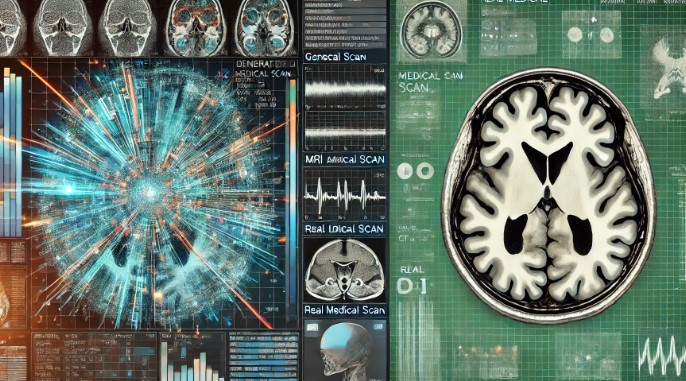Synthetic medical images are generated using AI techniques such as generative adversarial networks (GANs), diffusion models, and autoencoders. These methods create entirely new medical scans that mimic real images but are not derived from actual patient data. This technology is akin to AI-generated images of non-existent people, offering a scalable and ethical alternative to real-world medical imaging.
- AI-Generated Medical Images: AI techniques like GANs and diffusion models create synthetic medical images that mimic real scans without using actual patient data, offering a scalable and ethical solution for healthcare.
- Advantages: These synthetic images help address the demand for medical data while preserving patient privacy, making them ideal for sharing across institutions and enhancing diagnostic capabilities, especially in cases where certain scan types are unavailable.
- Risks: Potential misuse, such as deepfakes infiltrating hospital systems, and the risk of skewed AI model performance due to over-reliance on synthetic data, could lead to incorrect diagnoses or compromised healthcare outcomes.
- Collaboration for Accuracy: Partnering clinicians with AI engineers is essential to ensure synthetic data reflects real-world complexity, thus improving the reliability of AI-driven healthcare.
In healthcare, the demand for high-quality medical images often surpasses supply. Real medical images are costly and time-consuming to obtain, and privacy concerns further restrict their distribution. Synthetic images bridge this gap by providing a viable solution that can be shared across institutions without compromising patient confidentiality. They also facilitate intra- and inter-modality translation, enhancing diagnostic capabilities where certain scan types are unavailable.
Despite these benefits, the use of synthetic medical images carries inherent risks. The potential for misuse is significant, with concerns about deepfakes infiltrating hospital systems and introducing fraudulent data. Such scenarios could lead to incorrect diagnoses or financial exploitation through false insurance claims. Additionally, synthetic images may lack the depth and complexity of real-world data, potentially skewing AI model performance over time.
The issue of truth erosion looms large as reliance on synthetic images grows. If AI systems are trained predominantly on fabricated data, they may produce diagnoses that do not align with real-world cases. This could lead to a diagnostic model disconnected from actual patient experiences, raising questions about the reliability of AI-driven healthcare.
To mitigate these risks, collaboration between clinicians and AI engineers is crucial. Clinicians can provide insights from real-world practice, ensuring that AI models incorporate the nuances often missing from synthetic data. Such partnerships can enhance the clinical utility of AI models, balancing innovation with the need for accuracy and reliability.
While synthetic medical images hold transformative potential, caution is necessary to prevent them from distorting our understanding of human health. Much like the caution exercised in economic systems, where AI’s role is carefully managed, the use of synthetic images must be guided by ethical considerations and human oversight.





